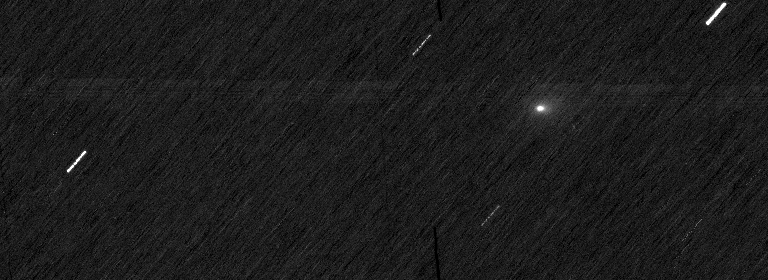![]() Press enter or click to view image in full size
Press enter or click to view image in full sizeImage of 3I/ATLAS, which appears as the fuzzy blob of light near the middle of the frame, on the background streaks of stars, taken on October 3, 2025 by the CaSSIS camera onboard the Mars orbiter ExoMars TGO. (Credit: ESA)
On October 3, 2025, the interstellar object 3I/ATLAS arrived within a distance of 30 million kilometers from Mars.
The European Space Agency (ESA) just released imaging data (accessible here) from their two Mars orbiters: ExoMars Trace Gas Orbiter (TGO) and Mars Express. The series of released color images with 5 second exposures from the Colour and Stereo Surface Imaging System (CaSSIS) onboard ExoMars Trace Gas Orbiter (TGO) show 3I/ATLAS as a fuzzy ball of light, qualitatively similar to the image taken on July 21, 2025 by the Hubble Space Telescope (as reported here and analyzed further here) at the much larger distance of 450 million kilometers. The Mars Express exposure time of 0.5 seconds was not sufficient to allow detection of 3I/ATLAS. It is unclear whether the spectrometers on both orbiters detected enough light for a spectral characterization of the chemical composition of 3I/ATLAS.
The angular resolution of the CaSSIS camera is 11.36 micro-radians (equivalent to 2.34 arcseconds) per pixel. At the shortest distance from 3I/ATLAS of about 30 million kilometers, this resolution translates to 340 kilometers. This pixel size is 1–2 orders of magnitude larger than the expected diameter of the nucleus of 3I/ATLAS, which ranges between a minimum value of 5 kilometers — based on the minimum mass of 33 billion tons needed to avoid detection of its non-gravitational acceleration over the past 5 months (as derived here), and the maximum diameter value of 46 kilometers — inferred from data of the SPHEREx space observatory based on the observed brightness and assumed albedo of 3I/ATLAS (as reported here).
Previously, the highest resolution image of 3I/ATLAS from the Hubble telescope, showed a bright ball of light with a width of order 4,000 kilometers, extended modestly towards the Sun. The line-of-sight from Earth was tilted by merely 10 degrees relative to the axis connecting 3I/ATLAS to the Sun. Since 1/sin(10 degrees)=5.76, the mildly extended Hubble fuzz suggests that on the scale of thousands of kilometers, the glow was extended towards the Sun with a physical length-to-width ratio of order 10.
Some of that extension is visible in the CaSSIS images. The passage of 3I/ATLAS over the Martian sky is viewed by Mars orbiters at a nearly perpendicular direction to the 3I/ATLAS-Sun axis, allowing a full view of the scale of the extension of the glow around 3I/ATLAS.
The width of the bright glow around 3I/ATLAS in the CaSSIS image is about twice the diameter of bright stars which serve as background point sources in the same image. This extent corresponds to a scale of 680 kilometers, an order of magnitude smaller than the width displayed in the Hubble image. It is therefore evident that CaSSIS can only detect the brightest region around the nucleus of 3I/ATLAS, while missing the lower surface-brightness envelope which is apparent in the Hubble image. In fact, we know that the plume of CO2 gas extends even further, out to at least 348,000 kilometers based on the SPHEREx data from August 8–12, 2025, (as reported here).
The primary mirror of CaSSIS is only 13.5 centimeter in diameter, having a surface area that is about 300 times smaller than that of the Hubble telescope mirror. The detection of the glow out to 680 kilometers in the CaSSIS image is consistent with the surface brightness profile from the Hubble image (see figure 2 here), amplified by the increase in the brightness of sunlight near Mars relative to where 3I/ATLAS was when the Hubble image was taken. This suggests that there was no major increase in outgassing from 3I/ATLAS over the past 3 months.
In the coming days, lower-quality images might be reported from the Moderate Resolution Imaging Camera (MoRIC) onboard China’s Tianwen-1 as well as the Emirates eXploration Imager onboard the Hope Orbiter of UAE’s Emirates Mars Mission.
But the best is yet to come. The highest resolution images, down to 30 kilometers per pixel, are expected from the High Resolution Imaging Experiment (HiRISE) camera onboard NASA’s Mars Reconnaissance Orbiter (MRO). The HiRISE camera has a diameter of 50 centimeters, allowing to detect the glow around 3I/ATLAS out to larger distances than possible with CaSSIS. The brightest pixel in the HiRISE image will provide the best constraint ever on the diameter of 3I/ATLAS.
We eagerly await NASA’s data. The brightest pixel in the HiRISE picture is worth more than the thousand words used in this essay to discuss the CaSSIS image.
ABOUT THE AUTHOR
Press enter or click to view image in full size(Image Credit: Chris Michel, National Academy of Sciences, 2023)
Avi Loeb is the head of the Galileo Project, founding director of Harvard University’s — Black Hole Initiative, director of the Institute for Theory and Computation at the Harvard-Smithsonian Center for Astrophysics, and the former chair of the astronomy department at Harvard University (2011–2020). He is a former member of the President’s Council of Advisors on Science and Technology and a former chair of the Board on Physics and Astronomy of the National Academies. He is the bestselling author of “Extraterrestrial: The First Sign of Intelligent Life Beyond Earth” and a co-author of the textbook “Life in the Cosmos”, both published in 2021. The paperback edition of his new book, titled “Interstellar”, was published in August 2024.
